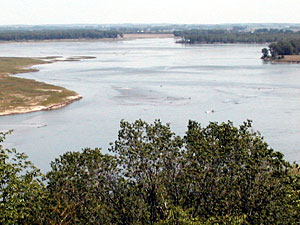Photos
Resources
Your Voice
| ||||||||||||||||||||||||||||||||||||||||||||
Water Wars: Missouri River politics
July 2, 2003
 |
| The Missouri River is more than a half mile wide near Vermillion, South Dakota. (MPR Photo/Mark Steil) |
Vermillion, South Dakota — The Missouri is a river engineer's dream. They've tinkered with it for at least a hundred years. Along its path from Montana to Missouri, the river's been cleaned-up, dammed and channeled. The main goals were to stop flooding and make the river safe for barge traffic. Downstream states are fighting to keep that original vision intact.
So far they've been successful using the courts and Congress to block change. But some people say more attention should be paid to the river's health.
"It's obvious where we're at isn't working because the species populations are declining," says river ecologist Larry Hesse.
 | |||
On a cool day in May, Hesse launches his boat into the Missouri near Vermillion, South Dakota. Hesse has studied the river for 30 years. Today, with a helper, he's examining fish. They shock the fish to the surface with electricity. Then they weigh, measure, and take a scale sample before tossing the fish back into the river. The catch includes catfish, suckers and bass. But Hesse sees fewer fish these days. He says changes to the river like dams and dikes have hurt fish reproductive cycles.
Take the sauger, a close relative of the walleye. Nearby Gavin's Point Dam spans the South Dakota-Nebraska border. Hesse says after the dam was completed in the 1950s, the sauger almost disappeared.
"They went from on the order of 300,000 per year being caught in the tail water of Gavin's Point to zero," says Hesse. "And they've never recovered."
Hesse says the biological diversity in the river needs to improve. But it would require some basic changes in how the river's managed.
"This thing's been messed up for a century," he says.
 | |||
Hesse got a taste of Missouri River politics as part of a national task force. The group recommended major changes in how the Missouri is managed. They want water levels to fluctuate more, like before the dams were built. Hesse says spring floods create a rich stew of plant material, breeding locations and insect life, perfect for reproduction.
But any changes along the river must be approved by the federal agency that oversees the Missouri, the U.S. Army Corps of Engineers. So far the Corps has not acted. Hesse would like to see others get involved in deciding the river's future.
"I favor a consortium of stakeholders to decide how we manage this river," says Hesse. "All the people that live in this basin. And people from all over the country who have a stake in preserving a national river. Its the second largest in this country. I mean this river opened up this country."
Hesse pilots his boat down a stretch of the Missouri more than half-a-mile wide. It's one of the few areas that still resembles the river's natural state. This is what Lewis and Clark saw during their famous expedition nearly 200 years ago. Since then dams have turned much of the Missouri into a series of lakes. And where it's not dammed, it's diked.
 | |||
In Iowa, Nebraska and Missouri the river is hemmed in to form a narrow shipping channel.
Even though Hesse and others favor changes in how the river is managed, that decision is up to the Army Corps of Engineers.
"I would like to please people," says Brigadier General David Fastabend. "I cannot however please everyone simultaneously, that's for sure."
Fastabend is commander of the Army Corps' Northwest Division which includes most of the Missouri River Basin. He's leaving the position after two years on the job. Like every other person to hold the post, he's been criticized over river management. Downstream states like Missouri want river policy that favors barge traffic. They want a consistent flow of water from the dams. Upstream states like South Dakota, North Dakota and Montana, want the river managed for fishing and boating. That means holding water at times to keep reservoir levels at the right depth.
Fastabend says no matter how much water the Corps releases, someone is unhappy.
 | |||
"All I can do is very carefully examine the applicable laws that congress gives me to implement and do my best to try to honor those mandates," says Fastabend.
Right now those mandates favor downstream states. At least nine lawsuits have been filed over river managment. The 8th U.S. Circuit Court of Appeals issued one of the most important rulings. The judges ordered the Corps to give a higher priority to downstream barge traffic than upstream fishing and boating.
Don Huffman was pleased by the ruling. He works for a barge line in St. Louis. Some of the battle over water levels has to do with where the Missouri flows into the Mississippi. The Mississippi carries 30 times more barge traffic than the Missouri. Barge operators like Huffman say during dry times, Missouri River water could decide whether the Mississippi stays open to shipping.
"60 to 75 percent of the water in the Mississippi River at St. Louis actually comes from the Missouri River," says Huffman. "So anything that's done on the Missouri River has a very strong effect on Mississippi River navigation."
The competing arguements over the Missouri River have prevented significant change. The Army Corps has tried unsuccessfully for 15 years to revise its river policies. Workers in the Corps' Northwest Division office poke fun at the failure. Along one wall, there is a photo gallery of past commanders who tried but failed to overhaul the corps' Missouri River policies. When a commander leaves, staffers draw an "X" through their former boss's picture.
The Corps first tried to change things when several species of fish and birds along the Missouri were declared "endangered". Later, drought brought calls for change. The river has receded so much the past two years that docks and boats are on dry ground in some parts of the Dakota's.
Commander Fastabend says river management has to balance competing interests: shipping, fishing, boating, agriculture, Indian lands, hydro-power and flood control. But Fastabend says everytime the Corps comes close to adopting new river policies, fresh objections delay the effort.
"We have a government and the Corps of Engineers as powerful as it is in management of the waterways is not all powerful," Fastabend says. "We work for the executive branch and if they tell us to relook something, we relook it."
Senate Minority Leader Tom Daschle calls the Corps' river policies an "extraordinary failure." Daschle, a South Dakota Democrat, says it favors downstream states. Daschle wants to transfer Missouri River management to some other federal agency.
Brigadier General Fastabend says the Corps will gladly step aside if someone else is assigned to manage the Missouri. When Fastabend took the Missouri River job he joked he would avoid the fate of his predecessors. But with just a short time left on the job and no policy breakthrough in sight, it looks like Fastabend too will exit with an X.
|
News Headlines
|
Related Subjects
|

